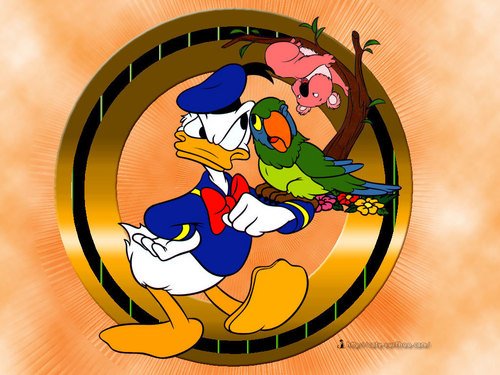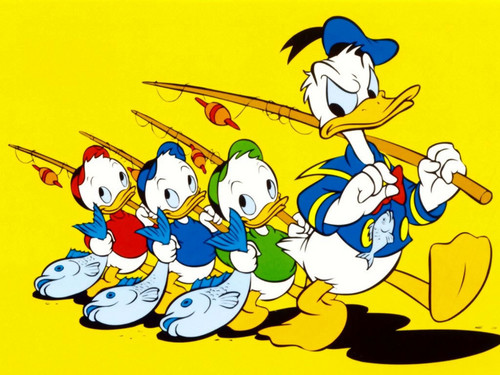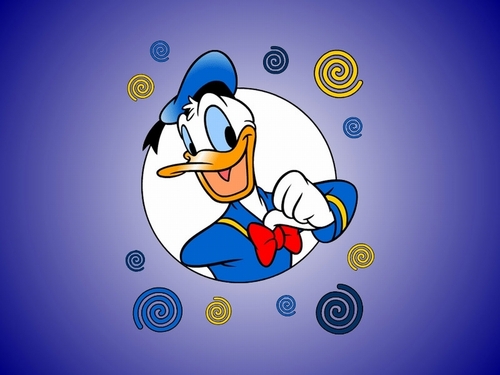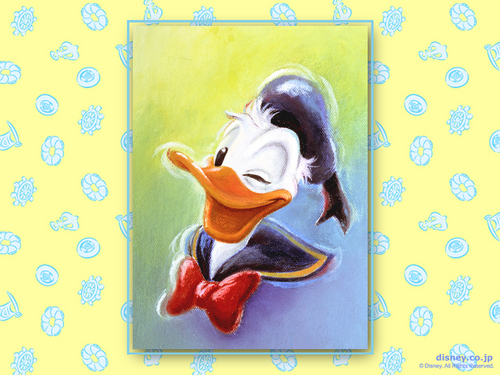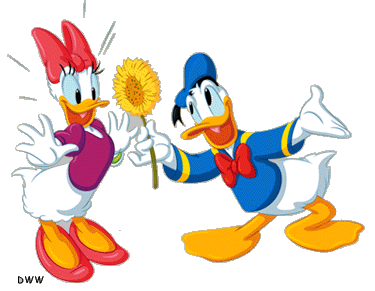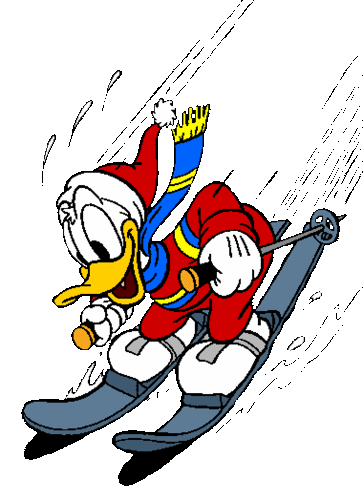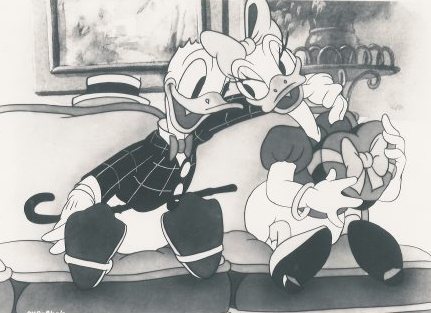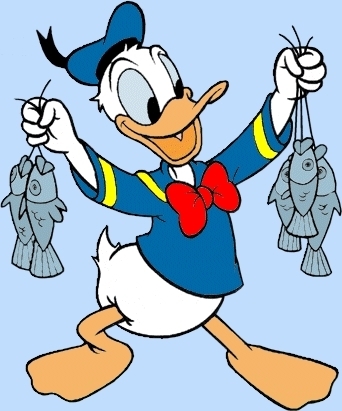Early debut
Donald may well have made his first printed appearance in Mickey chuột Annual 3 (published 1932; the annual for 1933), a 128-page British hardback. This book included the poem Mickey's Hoozoo, Witswitch and Wotswot, which listed all of Mickey's then-current chuồng, barnyard animal Những người bạn (most of Disney's major characters developed out of this chuồng, barnyard scenario). Among them was a vịt con named Donald Duck. Besides the name, however, there is little similarity between this character and the one introduced in The Wise Little Hen during 1934. Mickey chuột Annual 3 was drawn entirely bởi Wilfred Haughton.
[edit]Comic strip debut
The Donald of The Wise Little Hen made his printed debut in the newspaper comic strip adaptation of that cartoon. It was released between September 16 and December 16, 1934 in the Silly Symphonies Sunday pages bởi Ted Osborne and Al Taliaferro. On February 10, 1935, Donald appeared in the Mickey chuột daily strip bởi Ted Osborne and Floyd Gottfredson.
[edit]Featured character
A supporting character in Mickey's strip, Donald came to dominate the Silly Symphonies strips between August 30, 1936 and December 12, 1937. At the time, Ted Osborne was credited as writer and Al Taliaferro as artist and inker. Later studies of their work, however, hiển thị that Taliaferro probably contributed plot ideas and gags as well. The duo turned Donald from a countryman to a city dweller. They also introduced the first members of The con vịt, vịt family other than Donald himself, namely Donald's identical triplet nephews Huey, Dewey and Louie, who debuted on October 17, 1937. The sons of his sister Della con vịt, vịt (his sister in the animated shorts), the triplets were sent to spend some time with him as guests while their father recovered at the hospital from their latest prank. Nevertheless, Donald ended up serving as their adoptive parent.
[edit]Comic book debut
At this time the first Donald con vịt, vịt stories which was originally created for a comic book made their appearance. In the United Kingdom, Fleetway also created original stories with Donald Duck. "Donald and Donna", published in Mickey chuột Weekly # 67 (May 15, 1937) is the first Donald con vịt, vịt adventure ever. The story was 15 pages long and published in weekly episodes. The last appeared on August 21, 1937. All episodes were drawn bởi William A. Ward.
Disney had also licensed the Italian publishing house Mondadori to create stories with the Disney characters as their stars. The first to ngôi sao Donald, under his Italian name Paolino Paperino, was "Paolino Paperino e il mistero di Marte" (later reprinted in the USA as "The Secret of Mars", Donald con vịt, vịt 286) bởi Federico Pedrocchi, first published on December 30, 1937. The story was only 18 pages long and crude bởi later standards, but it is credited as the first to feature Donald in an adventuring rather than a comedic role. It is also the first of many to depict Donald as a không gian traveler, in this case traveling to Mars (See Mars in fiction).
[edit]Developments under Taliaferro
Back in the USA, Donald finally became the ngôi sao of his own newspaper comic strip. The Donald con vịt, vịt daily strip started on February 2, 1938, and the Donald con vịt, vịt Sunday page began December 10, 1939. Taliaferro drew both, this time co-operating with writer Bob Karp. Like before, Taliaferro continued to contribute plot ideas and gags, and some studies credit Taliaferro with most of the ideas that would turn his run of the strip into a so-called classic. He continued to work at the daily strip until October 10, 1968 and at the Sunday page until February 16, 1969.
Among other things, Taliaferro made several additions to Donald's supporting cast. Bolivar, Donald's pet St. Bernard first appeared in the strip on March 17, 1938, following his only animated appearance in Alpine Climbers (July 25, 1936). Donald's một giây cousin Gus Goose, the son of Fanny Coot, made his first appearance on May 9, 1938 -- the first member of the Coot Kin to appear (he would make the leap to phim hoạt hình a năm later in 1939's Donald's Cousin Gus). giống cúc, daisy con vịt, vịt first appeared in the strip on November 4, 1940, following her first proper animated appearance in Mr. con vịt, vịt Steps Out, first released on June 7, 1940. Donald's paternal grandmother Elviry (Elvira Coot, usually just called Grandma Duck) first appeared in a portrait on August 11, 1940 and in person on September 28, 1943. Taliaferro also reintroduced Donna con vịt, vịt as a separate character from Daisy. This old flame of Donald rivaled giống cúc, daisy for his affections between August 7, 1951 – August 18, 1951, before leaving him for another man. Though he did not create most of those characters, Taliaferro is credited with the development of their personalities as well as Donald's own personality. It has been đã đưa ý kiến that Taliaferro set the foundations for the later development of the character under Carl Barks and his successors.
[edit]First treasure hunt
Donald had already been familiar to the American đọc public through his newspaper comic strip bởi 1942. Then Disney licensed Western Publishing to create original comic book stories, with Disney characters as their stars. But the first American Donald con vịt, vịt story originally created for a comic book was created bởi Studio-employed artists. thêm specifically it was Donald con vịt, vịt Finds Pirate Gold, first published on October, 1942. The plot for the story had been originally suggested bởi Harry Reeves and Homer Brightman for a cartoon that never reached production. The notes for the cartoon were được trao to Bob Karp, who had been assigned to write Western's script. As intended, he used it as the basis for his story. Then it was được trao to Carl Barks and Jack Hannah to illustrate. Each of them drew half of the story's 64 pages. thêm specifically Barks drew pages #1, 2, 5, 12-40, Hannah drew pages #3, 4, 6-11, 41-64. The story places Donald and his nephews on a treasure hunt for the Mất tích treasure of Henry morgan and it manages to combine elements of humor and adventure with dramatic moments and mystery rather well. Though it is an early drawing effort bởi Barks, his attention to detail is already visible. The script demanded him to draw a Harbor and a sailing ship. Barks decided to use issues of National Geographic, which he collected, as reference sources. The result was a largely accurate depiction of his subjects. Probably as a result of every person contributing in the story's creation being thêm familiar with the standards of hoạt hình shorts and/or newspaper comic strips, rather than those of comic books, the story had very few dialogue scenes. The story is considered significant as both the first Donald story drawn bởi Barks for a comic book and the first to involve Donald in a treasure hunting expedition. Barks would later use the treasure-hunting theme in many of his own stories.
[edit]Origins of the comic book version
Until this point, the development of both the animated and the comic strip version of Donald was the result of a combined effort bởi a number of different creators, rather than a single one. But the comic book version of Donald was mainly developed bởi Carl Barks beginning in 1943.
The comic version had already diverged from the animated one in a number of ways, as was the case with Mickey at the time. When Donald con vịt, vịt gained his own separate newspaper comic strip, this meant that both he and his supporting characters had to be chẻ, phân chia, split off from the standard Disney cartoon world as featured in the Mickey chuột strip. This same division between chuột strips and con vịt, vịt strips was generally followed in the comic books. This suited Barks who did not particularly like the chuột stories. Carl later credited Floyd Gottfredson and his adventure stories for influencing his own work. However, he seemed to find Mickey and his supporting cast to be less than interesting as characters. In fact his only story with Mickey, Minnie, Goofy and Clarabell Cow as the featured characters was The Riddle of the Red Hat (first published in August, 1945, otherwise considered insignificant). Pete however remained his villain of choice for the first few years of his comic book work.
Barks largely did away with Donald's animated persona as a loafing, lazy hothead whose main quality is his hardly understandable quacking. To make him suitable for a comic-book story, Barks redefined his personality, gave him articulated speech, and shaded emotions. To give Donald a world to live in, Barks developed the city of Duckburg in the American state of Calisota. He was allowed to focus entirely on his own cast of Duckburg citizens like the richest con vịt, vịt in the world, Uncle Scrooge McDuck, lucky cousin Gladstone Gander, and the peculiar inventor gyro, con gyro, con quay hồi chuyển Gearloose. In the comics, Donald lives in a Duckburg house with Huey, Dewey and Louie Duck.
Much of this scenario would resurface in the 1987 TV series DuckTales. In that cartoon, however, Donald works and lives as a sailor on an aircraft carrier, and Huey, Dewey and Louie live with Uncle Scrooge for a while.
[edit]Early developments under Barks
Barks quit working at the Studio and found employment at Western Publishing with a starting pay of twelve dollars and fifty cents per page. According to a later interview bởi Barks, the company originally expected him to illustrate stories based on the scripts of others. They had sent him a script along with the following note: "Here is a 10-page story for Donald Duck. Hope that bạn like it. bạn are to stage it, of course. And if bạn see that it can be strengthened, hoặc that it deviates from Donald either in narration hoặc action, please make the improvements." Wanting to script his own stories, Barks started working on the script provided, freely changing whatever he wished. When he had finished with it, very little of the original remained. The story was The Victory Garden, first published in April, 1943. Barks had made his point bởi improving the original script beyond what had been expected of him. From then on, Barks both scripted and illustrated his stories.
His production during that năm seems to be at the pace he would follow for much of the following decade. Eight 10-pagers to be published in Walt Disney's Comics and Stories, published in a monthly basis, and one longer story for the sporadically published Donald Duck. In this case the story was The Mummy's Ring, 28-pages long, first published in September, 1943. The shorter stories would usually focus on Donald's everyday life and on comedy, while the longer ones were usually adventure stories set in exotic locales. The latter would often contain thêm dramatic elements and darker themes, and would place Donald and his nephews into dangerous and often near-fatal situations. To add realism to his illustration of those stories' settings, Barks would still seek reference sources. The magazine National Geographic would usually provide most of the material he needed.
In both cases the stories presented Donald's personality as having multiple aspects that would surface according to circumstance. hoặc as Barks would say later: "He was sometimes a villain, and he was often a real good guy and at all times he was just a blundering person like the average human being." Adding another note of realism was the fact that Donald could end up being either the victor hoặc the loser in his stories. And often even his victories were hollow. This gave a sense of realism to Donald's character and the characters and situations around him.
His nephews accompanied him in those stories and Barks also gave many aspects to their personalities. In some cases they acted as the mischievous brats Taliaferro had introduced, often antagonizing their uncle. In some cases they got in trouble and Donald would have to save them. But in others they proved remarkably resourceful and inventive, often helping their uncle out of a difficult situation. But most of the time, they would appear to have developed a deeper understanding of things and level of maturity than their uncle.
[edit]An early supporting-cast addition
The first recurring character that Barks would introduce was Donald's next-door Neighbor Jones. He was mentioned bởi name and made a cameo in Good Deeds, first published in July, 1943. He was mentioned as a neighbor that Donald likes to harass, but thêm as a form of teasing than anything thêm serious. Then he made his first full appearance in Good Neighbors, first published in November 11, 1943. There Donald and he appear to have agreed to a truce. But when they misinterpret a number of chance events to be covert attacks bởi their respective neighbor, they resume their fighting with renewed determination. In the process of their backyard warfare, they almost managed to destroy each other’s houses. The Nephews, who had enough of this fighting, reported it to the houses' owners. The two neighbors had to find new houses to rent. But to their disappointment, they found themselves as next-door neighbors. The fighting, not surprisingly, continues. Jones seems to always be in a bad mood and Donald just serves to make him angry. The two irrational and easily irritated neighbors would serve as the focus of a number of 10-pagers.
[edit]Introduction to Scrooge and Gladstone
The tiếp theo two recurring characters to be introduced bởi Barks were arguably thêm significant. Donald's maternal uncle Scrooge McDuck made his first appearance in giáng sinh on chịu, gấu Mountain, first published on December, 1947. The first member of The Clan McDuck to appear, his name was based on Ebenezer Scrooge, another fictional character from Charles Dickens's A giáng sinh Carol. The story's tiêu đề was based on A Night on Bald Mountain bởi Modest Mussorgsky, presumably better known to Disney những người hâm mộ from a scene of Fantasia featuring Chernabog. Scrooge's first appearance was almost immediately followed bởi that of Donald's first cousin Gladstone ngây ngô, gander in Wintertime Wager, first published on January, 1948. In fact this is acknowledged in the stories' internal chronology. The first story occurs at December 24, 1947 and has a scene occurring on the night of December 25, 1947. The một giây occurs on the morning of December 25, 1947.
Both characters didn't yet have their familiar characteristics. Gladstone was presented as a rather arrogant cousin that had a claim on Donald's house. thêm specifically, in summer he had gotten Donald to agree to a wager. On giáng sinh he had to either swim in a lake near his house hoặc to pass his house to Gladstone. Gladstone does not yet lay claim to the tiêu đề of The Luckiest con vịt, vịt In the World. Daisy, who saves Donald from losing his house, still seems to have no interest in Gladstone. Their tình yêu tam giác hadn't formed yet.
As for Scrooge, he was a bearded, bespectacled, reasonably wealthy old man who is visibly leaning on his cane. He was living in isolation in a Huge Mansion, which is đã đưa ý kiến to be influenced bởi that present in Orson Welles's Citizen Kane. Concerning his sense of humor, he planned to entertain himself bởi inviting his nephews to his mountain lều, cabin and then scaring them out of it.
[edit]Developments on Gladstone
In the following years both characters would become prominent members of Donald's supporting cast. In Gladstone's case, he soon started to rival his cousin in a number of personal wagers and organized contests. His incredible luck was introduced in Race to the South Seas, first published in 1949. This story also was the first to present Donald and Gladstone trying to win Scrooge's favor in order for one of them to become his heir. They both claim to be Scrooge's closest living relative, as Donald is the son of Scrooge's sister and Gladstone is the son of Scrooge's sister's sister-in-law. Scrooge would later express his doubts that the latter constitutes an actual familial relationship. Gladstone would also rival his cousin in a treasure hunt in Luck of the North, first published in December, 1949. The later story is still considered as one of his strongest appearances. It is one of the rare occasions where his luck is combined with conscious efforts on his part and he proves to be a rather competent and resourceful adventurer in his own right. Gladstone soon also became Donald's rival for Daisy's affections. The love-triangle of Donald, giống cúc, daisy and Gladstone would become an on-going theme for the following decades. giống cúc, daisy actually dates both cousins and is đã đưa ý kiến to have them both wrapped around her little finger.
[edit]Losing ground to Scrooge
While Gladstone's development and establishment seemed to take about a năm after his appearance, Barks continued to experiment with Scrooge's appearance and personality for the following four years. Barks would later claim that he originally only intended to use Scrooge as a one-shot character, but then he decided he could prove useful in further stories.
Scrooge was soon established as a recurring character and various stories cast him as a featured character alongside Donald. bởi 1952, Scrooge had gained a magazine of his own. From then on Barks produced most of his longer stories in Uncle Scrooge with Scrooge as their ngôi sao and focusing in adventure, while his ten-pagers continued to feature Donald as their ngôi sao and focused on comedy. Scrooge became the central figure of the stories while Donald and their nephews were cast as Scrooge's Helpers, hired helping-hands who followed Scrooge around the world. Other contemporary creators also reflected this change of focus from Donald to Scrooge in stories. Since then Scrooge remains the central figure of their Universe, coining the term Scrooge McDuck Universe.
[edit]Further developments
Donald as Paperinik. Art bởi Marco Rota.
Barks wasn't the only tác giả to develop Donald. All over the world hundreds of other authors have used the character, sometimes with great results.
For example the Disney Studio artists, who made comics directly for the European market. Two of them, Dick Kinney and Al Hubbard created Donald's cousin Fethry Duck.
The American artists Vic Lockman and Tony Strobl, who were working directly for the American comic books, created Moby Duck. Strobl was one of the most productive Disney artists of all time, and drew a lot of stories which Barks wrote after his retirement. In the 1990s, these scripts were re-drawn bởi Dutch artist Daan Jippes.
Italian publisher Mondadori created many of the stories that were published throughout Europe. They also introduced numerous new characters who are today well known in Europe. One example is Donald Duck's alter-ego, a superhero called Paperinik in Italian, created bởi Guido Martina and Giovan Battista Carpi.
Giorgio Cavazzano and Carlo Chendi created Honkey đi kart, go kart (Umperio Bogarto in Italian), a detective whose name is an obvious parody on Humphrey Bogart. They also created OK Quack, an extraterrestrial con vịt, vịt who landed on earth in a spaceship in the shape of a coin. He however Mất tích his spaceship, and befriended Scrooge, and now is allowed to tìm kiếm through his moneybin time after time, looking for his ship.
Romano Scarpa, who was a very important and influential Italian Disney artist, created Brigitta McBridge, a female con vịt, vịt who is madly in tình yêu with Scrooge. Her affections are never answered bởi him, though, but she keeps trying. Scarpa also came up with Dickie Duck, the granddaughter of Glittering Goldie (Scrooge's possible love-interest from his days in the Klondike) and Kildare Coot, a nephew of Grandma Duck.
Italian artist Corrado Mastantuono created Bum Bum Ghigno, a cynical, grumpy and not too good looking con vịt, vịt who teams up with Donald and gyro, con gyro, con quay hồi chuyển a lot.
The American artist William van Horn also introduced a new character: Rumpus McFowl, an old and rather corpulent con vịt, vịt with a giant appetite and laziness, who is first đã đưa ý kiến to be a cousin of Scrooge. Only later, Scrooge reveals to his nephews Rumpus is actually his half-brother. Later, Rumpus also finds out.
Working for the Danish editor Egmont, artist Daniel Branca and script-writers Paul Halas and Charlie Martin created Sonny Seagull, an orphan who befriends Huey, Duey and Louie, and his rival, Mr. Phelps.
The most productive Duck-artist today is Victor Arriagada Rios, who is better known under the name Vicar. He has his own studio where he and his assistants draw the stories send in bởi Egmont. Vicar created the character Oono, a pre-historic princess who travelled to Duckburg in the 1990s bởi using Gyro's time-machine.
The best-known and most được ưa chuộng Duck-artist of this time is Keno Don Rosa. He started doing Disney comics in 1987 for the American publisher Gladstone. He later worked briefly for the Dutch editors, but moved to work directly for Egmont soon afterwards. He created a lot of sequels to Barks' stories, and even a 12-part series of stories about the life of Scrooge McDuck, which won him two Eisner awards. Not all Barks-fans are happy with his work, though, and they claim he's destroying Barks' carefully built world.
Other important artists who have worked with Donald are Freddy Milton and Daan Jippes, who made 18 ten-pagers which some claim are as good as Barks' work.
[edit]Donald's character history
According to Disney comics tác giả Don Rosa, Donald was born somewhere around 1920—however, this is not an official năm of birth. According to Carl Barks' Donald con vịt, vịt family cây (later developed and re-built bởi Don Rosa for the Danish publishing house Egmont), Donald's parents are Hortense McDuck and Quackmore Duck. Donald’s sister is named Della Thelma Duck, but neither she nor Donald's parents appear in the hoạt hình hoặc comics except for special cases, like The Life and Times of Scrooge McDuck. According to Rosa, Donald and Della are twins.
According to Donald con vịt, vịt comics #85, Donald con vịt, vịt grew up in Elm City, a town not far from Duckburg. [1]
[edit]Barks's các bình luận on Donald and his stories
"The thing that I consider most important about my work is this: I told it like it is. I told my readers that the bad guys have a little of good in them, and the good guys have a lot of bad in them, and that bạn can't depend on anything much; nothing is always going to turn out roses." - May 29, 1973.
"In fact I laid it right on the line. There was no difference between my characters and the life my readers were going to have to face. When the Ducks went out in the desert, so did Joe Blow down the đường phố, street with his kids. When Donald got buffeted around, I tried to put it over in such a way that kids would see it could happen to them. Unlike the superhero comics, my comics had parallels in human experience."
"I always felt myself to be an unlucky person like Donald, who is a victim of so many circumstances. But there isn't a person in the United States who couldn't identify with him. He is everything, he is everybody; he makes the same mistakes that we all make."
"I carried in my head the idea that there was a whole town and a whole family of characters around these ducks at all times, he recalls. There were cousins and nephews and nieces, and villains and bankers and all kinds of people that they dealt with in everyday life. So whenever I needed a character, I would create one that apparently had been around but just hadn't been used yet. The way I presented these characters was the way they were in my head: they had been there all the time". - August 4, 1975.
"I've always looked upon the Ducks as caricature human beings. Perhaps I've been years nghề viết văn in that middle world that J. R. R. Tolkien describes, and never knew it." (After his retirement Barks started đọc Tolkien, and discovered similarities between their stories. At this point he was comparing his Ducks to Tolkien's hobbits of Middle-earth.)
"I broadened his character out very much. Instead of making just a quarrelsome little guy out of him, I made a sympathetic character. He was sometimes a villain, and he was often a real good guy and at all times he was just a blundering person like the average human being, and I think that is one of the reasons people like the duck." - Spring, 1981.
"I didn't expect any great rosy things out of life for my characters and it's a good way to be, I think. If bạn get too darned optimistic, your stuff gets sweet like Pollyanna."
"I even tried to tone down the malicious streak in Donald's character. I resented it in Bugs Bunny; it just turned me off. I thought: why put that same character into Donald and turn off millions of readers? It was okay for the Ducks from time to time, provided there were reasons for it."
A famous quote from Donald con vịt, vịt himself:
"Four dollars is very little money when bạn got'em; but a heck of a lot of money when bạn ain't got'em." (From the Carl Barks story "A giáng sinh for Shacktown".)
[edit]Donald's car
Taliaferro introduced Donald's car, a 1934 Belchfire Runabout, on July 1, 1938. Donald is đã đưa ý kiến to have constructed it himself from spare parts of various sources. It is recognizable bởi its license plate number 313. The car is modeled around the 1938 American Bantam. Though Donald briefly drove other cars both in Taliaferro's strip and in later stories, this car would stay with Donald throughout the following decades. The car's constant breakdowns and need of repairs is often used as a nguồn of humor. Immediately recognizable bởi readers, it seems to have become as much a trademark of Donald as his sailor áo sơ mi and cap. His alias Paperinik on the other side has the 313 (which sports a different plate, namely X) equipped with a lot of high tech gadgets bởi gyro, con gyro, con quay hồi chuyển Gearloose to combat crime. in "Recalled Wreck", Donald tells his nephews he can't buy new car parts instead of having them fixed because his car is made of parts that are no longer produced.
[edit]Comic books
Donald may well have made his first printed appearance in Mickey chuột Annual 3 (published 1932; the annual for 1933), a 128-page British hardback. This book included the poem Mickey's Hoozoo, Witswitch and Wotswot, which listed all of Mickey's then-current chuồng, barnyard animal Những người bạn (most of Disney's major characters developed out of this chuồng, barnyard scenario). Among them was a vịt con named Donald Duck. Besides the name, however, there is little similarity between this character and the one introduced in The Wise Little Hen during 1934. Mickey chuột Annual 3 was drawn entirely bởi Wilfred Haughton.
[edit]Comic strip debut
The Donald of The Wise Little Hen made his printed debut in the newspaper comic strip adaptation of that cartoon. It was released between September 16 and December 16, 1934 in the Silly Symphonies Sunday pages bởi Ted Osborne and Al Taliaferro. On February 10, 1935, Donald appeared in the Mickey chuột daily strip bởi Ted Osborne and Floyd Gottfredson.
[edit]Featured character
A supporting character in Mickey's strip, Donald came to dominate the Silly Symphonies strips between August 30, 1936 and December 12, 1937. At the time, Ted Osborne was credited as writer and Al Taliaferro as artist and inker. Later studies of their work, however, hiển thị that Taliaferro probably contributed plot ideas and gags as well. The duo turned Donald from a countryman to a city dweller. They also introduced the first members of The con vịt, vịt family other than Donald himself, namely Donald's identical triplet nephews Huey, Dewey and Louie, who debuted on October 17, 1937. The sons of his sister Della con vịt, vịt (his sister in the animated shorts), the triplets were sent to spend some time with him as guests while their father recovered at the hospital from their latest prank. Nevertheless, Donald ended up serving as their adoptive parent.
[edit]Comic book debut
At this time the first Donald con vịt, vịt stories which was originally created for a comic book made their appearance. In the United Kingdom, Fleetway also created original stories with Donald Duck. "Donald and Donna", published in Mickey chuột Weekly # 67 (May 15, 1937) is the first Donald con vịt, vịt adventure ever. The story was 15 pages long and published in weekly episodes. The last appeared on August 21, 1937. All episodes were drawn bởi William A. Ward.
Disney had also licensed the Italian publishing house Mondadori to create stories with the Disney characters as their stars. The first to ngôi sao Donald, under his Italian name Paolino Paperino, was "Paolino Paperino e il mistero di Marte" (later reprinted in the USA as "The Secret of Mars", Donald con vịt, vịt 286) bởi Federico Pedrocchi, first published on December 30, 1937. The story was only 18 pages long and crude bởi later standards, but it is credited as the first to feature Donald in an adventuring rather than a comedic role. It is also the first of many to depict Donald as a không gian traveler, in this case traveling to Mars (See Mars in fiction).
[edit]Developments under Taliaferro
Back in the USA, Donald finally became the ngôi sao of his own newspaper comic strip. The Donald con vịt, vịt daily strip started on February 2, 1938, and the Donald con vịt, vịt Sunday page began December 10, 1939. Taliaferro drew both, this time co-operating with writer Bob Karp. Like before, Taliaferro continued to contribute plot ideas and gags, and some studies credit Taliaferro with most of the ideas that would turn his run of the strip into a so-called classic. He continued to work at the daily strip until October 10, 1968 and at the Sunday page until February 16, 1969.
Among other things, Taliaferro made several additions to Donald's supporting cast. Bolivar, Donald's pet St. Bernard first appeared in the strip on March 17, 1938, following his only animated appearance in Alpine Climbers (July 25, 1936). Donald's một giây cousin Gus Goose, the son of Fanny Coot, made his first appearance on May 9, 1938 -- the first member of the Coot Kin to appear (he would make the leap to phim hoạt hình a năm later in 1939's Donald's Cousin Gus). giống cúc, daisy con vịt, vịt first appeared in the strip on November 4, 1940, following her first proper animated appearance in Mr. con vịt, vịt Steps Out, first released on June 7, 1940. Donald's paternal grandmother Elviry (Elvira Coot, usually just called Grandma Duck) first appeared in a portrait on August 11, 1940 and in person on September 28, 1943. Taliaferro also reintroduced Donna con vịt, vịt as a separate character from Daisy. This old flame of Donald rivaled giống cúc, daisy for his affections between August 7, 1951 – August 18, 1951, before leaving him for another man. Though he did not create most of those characters, Taliaferro is credited with the development of their personalities as well as Donald's own personality. It has been đã đưa ý kiến that Taliaferro set the foundations for the later development of the character under Carl Barks and his successors.
[edit]First treasure hunt
Donald had already been familiar to the American đọc public through his newspaper comic strip bởi 1942. Then Disney licensed Western Publishing to create original comic book stories, with Disney characters as their stars. But the first American Donald con vịt, vịt story originally created for a comic book was created bởi Studio-employed artists. thêm specifically it was Donald con vịt, vịt Finds Pirate Gold, first published on October, 1942. The plot for the story had been originally suggested bởi Harry Reeves and Homer Brightman for a cartoon that never reached production. The notes for the cartoon were được trao to Bob Karp, who had been assigned to write Western's script. As intended, he used it as the basis for his story. Then it was được trao to Carl Barks and Jack Hannah to illustrate. Each of them drew half of the story's 64 pages. thêm specifically Barks drew pages #1, 2, 5, 12-40, Hannah drew pages #3, 4, 6-11, 41-64. The story places Donald and his nephews on a treasure hunt for the Mất tích treasure of Henry morgan and it manages to combine elements of humor and adventure with dramatic moments and mystery rather well. Though it is an early drawing effort bởi Barks, his attention to detail is already visible. The script demanded him to draw a Harbor and a sailing ship. Barks decided to use issues of National Geographic, which he collected, as reference sources. The result was a largely accurate depiction of his subjects. Probably as a result of every person contributing in the story's creation being thêm familiar with the standards of hoạt hình shorts and/or newspaper comic strips, rather than those of comic books, the story had very few dialogue scenes. The story is considered significant as both the first Donald story drawn bởi Barks for a comic book and the first to involve Donald in a treasure hunting expedition. Barks would later use the treasure-hunting theme in many of his own stories.
[edit]Origins of the comic book version
Until this point, the development of both the animated and the comic strip version of Donald was the result of a combined effort bởi a number of different creators, rather than a single one. But the comic book version of Donald was mainly developed bởi Carl Barks beginning in 1943.
The comic version had already diverged from the animated one in a number of ways, as was the case with Mickey at the time. When Donald con vịt, vịt gained his own separate newspaper comic strip, this meant that both he and his supporting characters had to be chẻ, phân chia, split off from the standard Disney cartoon world as featured in the Mickey chuột strip. This same division between chuột strips and con vịt, vịt strips was generally followed in the comic books. This suited Barks who did not particularly like the chuột stories. Carl later credited Floyd Gottfredson and his adventure stories for influencing his own work. However, he seemed to find Mickey and his supporting cast to be less than interesting as characters. In fact his only story with Mickey, Minnie, Goofy and Clarabell Cow as the featured characters was The Riddle of the Red Hat (first published in August, 1945, otherwise considered insignificant). Pete however remained his villain of choice for the first few years of his comic book work.
Barks largely did away with Donald's animated persona as a loafing, lazy hothead whose main quality is his hardly understandable quacking. To make him suitable for a comic-book story, Barks redefined his personality, gave him articulated speech, and shaded emotions. To give Donald a world to live in, Barks developed the city of Duckburg in the American state of Calisota. He was allowed to focus entirely on his own cast of Duckburg citizens like the richest con vịt, vịt in the world, Uncle Scrooge McDuck, lucky cousin Gladstone Gander, and the peculiar inventor gyro, con gyro, con quay hồi chuyển Gearloose. In the comics, Donald lives in a Duckburg house with Huey, Dewey and Louie Duck.
Much of this scenario would resurface in the 1987 TV series DuckTales. In that cartoon, however, Donald works and lives as a sailor on an aircraft carrier, and Huey, Dewey and Louie live with Uncle Scrooge for a while.
[edit]Early developments under Barks
Barks quit working at the Studio and found employment at Western Publishing with a starting pay of twelve dollars and fifty cents per page. According to a later interview bởi Barks, the company originally expected him to illustrate stories based on the scripts of others. They had sent him a script along with the following note: "Here is a 10-page story for Donald Duck. Hope that bạn like it. bạn are to stage it, of course. And if bạn see that it can be strengthened, hoặc that it deviates from Donald either in narration hoặc action, please make the improvements." Wanting to script his own stories, Barks started working on the script provided, freely changing whatever he wished. When he had finished with it, very little of the original remained. The story was The Victory Garden, first published in April, 1943. Barks had made his point bởi improving the original script beyond what had been expected of him. From then on, Barks both scripted and illustrated his stories.
His production during that năm seems to be at the pace he would follow for much of the following decade. Eight 10-pagers to be published in Walt Disney's Comics and Stories, published in a monthly basis, and one longer story for the sporadically published Donald Duck. In this case the story was The Mummy's Ring, 28-pages long, first published in September, 1943. The shorter stories would usually focus on Donald's everyday life and on comedy, while the longer ones were usually adventure stories set in exotic locales. The latter would often contain thêm dramatic elements and darker themes, and would place Donald and his nephews into dangerous and often near-fatal situations. To add realism to his illustration of those stories' settings, Barks would still seek reference sources. The magazine National Geographic would usually provide most of the material he needed.
In both cases the stories presented Donald's personality as having multiple aspects that would surface according to circumstance. hoặc as Barks would say later: "He was sometimes a villain, and he was often a real good guy and at all times he was just a blundering person like the average human being." Adding another note of realism was the fact that Donald could end up being either the victor hoặc the loser in his stories. And often even his victories were hollow. This gave a sense of realism to Donald's character and the characters and situations around him.
His nephews accompanied him in those stories and Barks also gave many aspects to their personalities. In some cases they acted as the mischievous brats Taliaferro had introduced, often antagonizing their uncle. In some cases they got in trouble and Donald would have to save them. But in others they proved remarkably resourceful and inventive, often helping their uncle out of a difficult situation. But most of the time, they would appear to have developed a deeper understanding of things and level of maturity than their uncle.
[edit]An early supporting-cast addition
The first recurring character that Barks would introduce was Donald's next-door Neighbor Jones. He was mentioned bởi name and made a cameo in Good Deeds, first published in July, 1943. He was mentioned as a neighbor that Donald likes to harass, but thêm as a form of teasing than anything thêm serious. Then he made his first full appearance in Good Neighbors, first published in November 11, 1943. There Donald and he appear to have agreed to a truce. But when they misinterpret a number of chance events to be covert attacks bởi their respective neighbor, they resume their fighting with renewed determination. In the process of their backyard warfare, they almost managed to destroy each other’s houses. The Nephews, who had enough of this fighting, reported it to the houses' owners. The two neighbors had to find new houses to rent. But to their disappointment, they found themselves as next-door neighbors. The fighting, not surprisingly, continues. Jones seems to always be in a bad mood and Donald just serves to make him angry. The two irrational and easily irritated neighbors would serve as the focus of a number of 10-pagers.
[edit]Introduction to Scrooge and Gladstone
The tiếp theo two recurring characters to be introduced bởi Barks were arguably thêm significant. Donald's maternal uncle Scrooge McDuck made his first appearance in giáng sinh on chịu, gấu Mountain, first published on December, 1947. The first member of The Clan McDuck to appear, his name was based on Ebenezer Scrooge, another fictional character from Charles Dickens's A giáng sinh Carol. The story's tiêu đề was based on A Night on Bald Mountain bởi Modest Mussorgsky, presumably better known to Disney những người hâm mộ from a scene of Fantasia featuring Chernabog. Scrooge's first appearance was almost immediately followed bởi that of Donald's first cousin Gladstone ngây ngô, gander in Wintertime Wager, first published on January, 1948. In fact this is acknowledged in the stories' internal chronology. The first story occurs at December 24, 1947 and has a scene occurring on the night of December 25, 1947. The một giây occurs on the morning of December 25, 1947.
Both characters didn't yet have their familiar characteristics. Gladstone was presented as a rather arrogant cousin that had a claim on Donald's house. thêm specifically, in summer he had gotten Donald to agree to a wager. On giáng sinh he had to either swim in a lake near his house hoặc to pass his house to Gladstone. Gladstone does not yet lay claim to the tiêu đề of The Luckiest con vịt, vịt In the World. Daisy, who saves Donald from losing his house, still seems to have no interest in Gladstone. Their tình yêu tam giác hadn't formed yet.
As for Scrooge, he was a bearded, bespectacled, reasonably wealthy old man who is visibly leaning on his cane. He was living in isolation in a Huge Mansion, which is đã đưa ý kiến to be influenced bởi that present in Orson Welles's Citizen Kane. Concerning his sense of humor, he planned to entertain himself bởi inviting his nephews to his mountain lều, cabin and then scaring them out of it.
[edit]Developments on Gladstone
In the following years both characters would become prominent members of Donald's supporting cast. In Gladstone's case, he soon started to rival his cousin in a number of personal wagers and organized contests. His incredible luck was introduced in Race to the South Seas, first published in 1949. This story also was the first to present Donald and Gladstone trying to win Scrooge's favor in order for one of them to become his heir. They both claim to be Scrooge's closest living relative, as Donald is the son of Scrooge's sister and Gladstone is the son of Scrooge's sister's sister-in-law. Scrooge would later express his doubts that the latter constitutes an actual familial relationship. Gladstone would also rival his cousin in a treasure hunt in Luck of the North, first published in December, 1949. The later story is still considered as one of his strongest appearances. It is one of the rare occasions where his luck is combined with conscious efforts on his part and he proves to be a rather competent and resourceful adventurer in his own right. Gladstone soon also became Donald's rival for Daisy's affections. The love-triangle of Donald, giống cúc, daisy and Gladstone would become an on-going theme for the following decades. giống cúc, daisy actually dates both cousins and is đã đưa ý kiến to have them both wrapped around her little finger.
[edit]Losing ground to Scrooge
While Gladstone's development and establishment seemed to take about a năm after his appearance, Barks continued to experiment with Scrooge's appearance and personality for the following four years. Barks would later claim that he originally only intended to use Scrooge as a one-shot character, but then he decided he could prove useful in further stories.
Scrooge was soon established as a recurring character and various stories cast him as a featured character alongside Donald. bởi 1952, Scrooge had gained a magazine of his own. From then on Barks produced most of his longer stories in Uncle Scrooge with Scrooge as their ngôi sao and focusing in adventure, while his ten-pagers continued to feature Donald as their ngôi sao and focused on comedy. Scrooge became the central figure of the stories while Donald and their nephews were cast as Scrooge's Helpers, hired helping-hands who followed Scrooge around the world. Other contemporary creators also reflected this change of focus from Donald to Scrooge in stories. Since then Scrooge remains the central figure of their Universe, coining the term Scrooge McDuck Universe.
[edit]Further developments
Donald as Paperinik. Art bởi Marco Rota.
Barks wasn't the only tác giả to develop Donald. All over the world hundreds of other authors have used the character, sometimes with great results.
For example the Disney Studio artists, who made comics directly for the European market. Two of them, Dick Kinney and Al Hubbard created Donald's cousin Fethry Duck.
The American artists Vic Lockman and Tony Strobl, who were working directly for the American comic books, created Moby Duck. Strobl was one of the most productive Disney artists of all time, and drew a lot of stories which Barks wrote after his retirement. In the 1990s, these scripts were re-drawn bởi Dutch artist Daan Jippes.
Italian publisher Mondadori created many of the stories that were published throughout Europe. They also introduced numerous new characters who are today well known in Europe. One example is Donald Duck's alter-ego, a superhero called Paperinik in Italian, created bởi Guido Martina and Giovan Battista Carpi.
Giorgio Cavazzano and Carlo Chendi created Honkey đi kart, go kart (Umperio Bogarto in Italian), a detective whose name is an obvious parody on Humphrey Bogart. They also created OK Quack, an extraterrestrial con vịt, vịt who landed on earth in a spaceship in the shape of a coin. He however Mất tích his spaceship, and befriended Scrooge, and now is allowed to tìm kiếm through his moneybin time after time, looking for his ship.
Romano Scarpa, who was a very important and influential Italian Disney artist, created Brigitta McBridge, a female con vịt, vịt who is madly in tình yêu with Scrooge. Her affections are never answered bởi him, though, but she keeps trying. Scarpa also came up with Dickie Duck, the granddaughter of Glittering Goldie (Scrooge's possible love-interest from his days in the Klondike) and Kildare Coot, a nephew of Grandma Duck.
Italian artist Corrado Mastantuono created Bum Bum Ghigno, a cynical, grumpy and not too good looking con vịt, vịt who teams up with Donald and gyro, con gyro, con quay hồi chuyển a lot.
The American artist William van Horn also introduced a new character: Rumpus McFowl, an old and rather corpulent con vịt, vịt with a giant appetite and laziness, who is first đã đưa ý kiến to be a cousin of Scrooge. Only later, Scrooge reveals to his nephews Rumpus is actually his half-brother. Later, Rumpus also finds out.
Working for the Danish editor Egmont, artist Daniel Branca and script-writers Paul Halas and Charlie Martin created Sonny Seagull, an orphan who befriends Huey, Duey and Louie, and his rival, Mr. Phelps.
The most productive Duck-artist today is Victor Arriagada Rios, who is better known under the name Vicar. He has his own studio where he and his assistants draw the stories send in bởi Egmont. Vicar created the character Oono, a pre-historic princess who travelled to Duckburg in the 1990s bởi using Gyro's time-machine.
The best-known and most được ưa chuộng Duck-artist of this time is Keno Don Rosa. He started doing Disney comics in 1987 for the American publisher Gladstone. He later worked briefly for the Dutch editors, but moved to work directly for Egmont soon afterwards. He created a lot of sequels to Barks' stories, and even a 12-part series of stories about the life of Scrooge McDuck, which won him two Eisner awards. Not all Barks-fans are happy with his work, though, and they claim he's destroying Barks' carefully built world.
Other important artists who have worked with Donald are Freddy Milton and Daan Jippes, who made 18 ten-pagers which some claim are as good as Barks' work.
[edit]Donald's character history
According to Disney comics tác giả Don Rosa, Donald was born somewhere around 1920—however, this is not an official năm of birth. According to Carl Barks' Donald con vịt, vịt family cây (later developed and re-built bởi Don Rosa for the Danish publishing house Egmont), Donald's parents are Hortense McDuck and Quackmore Duck. Donald’s sister is named Della Thelma Duck, but neither she nor Donald's parents appear in the hoạt hình hoặc comics except for special cases, like The Life and Times of Scrooge McDuck. According to Rosa, Donald and Della are twins.
According to Donald con vịt, vịt comics #85, Donald con vịt, vịt grew up in Elm City, a town not far from Duckburg. [1]
[edit]Barks's các bình luận on Donald and his stories
"The thing that I consider most important about my work is this: I told it like it is. I told my readers that the bad guys have a little of good in them, and the good guys have a lot of bad in them, and that bạn can't depend on anything much; nothing is always going to turn out roses." - May 29, 1973.
"In fact I laid it right on the line. There was no difference between my characters and the life my readers were going to have to face. When the Ducks went out in the desert, so did Joe Blow down the đường phố, street with his kids. When Donald got buffeted around, I tried to put it over in such a way that kids would see it could happen to them. Unlike the superhero comics, my comics had parallels in human experience."
"I always felt myself to be an unlucky person like Donald, who is a victim of so many circumstances. But there isn't a person in the United States who couldn't identify with him. He is everything, he is everybody; he makes the same mistakes that we all make."
"I carried in my head the idea that there was a whole town and a whole family of characters around these ducks at all times, he recalls. There were cousins and nephews and nieces, and villains and bankers and all kinds of people that they dealt with in everyday life. So whenever I needed a character, I would create one that apparently had been around but just hadn't been used yet. The way I presented these characters was the way they were in my head: they had been there all the time". - August 4, 1975.
"I've always looked upon the Ducks as caricature human beings. Perhaps I've been years nghề viết văn in that middle world that J. R. R. Tolkien describes, and never knew it." (After his retirement Barks started đọc Tolkien, and discovered similarities between their stories. At this point he was comparing his Ducks to Tolkien's hobbits of Middle-earth.)
"I broadened his character out very much. Instead of making just a quarrelsome little guy out of him, I made a sympathetic character. He was sometimes a villain, and he was often a real good guy and at all times he was just a blundering person like the average human being, and I think that is one of the reasons people like the duck." - Spring, 1981.
"I didn't expect any great rosy things out of life for my characters and it's a good way to be, I think. If bạn get too darned optimistic, your stuff gets sweet like Pollyanna."
"I even tried to tone down the malicious streak in Donald's character. I resented it in Bugs Bunny; it just turned me off. I thought: why put that same character into Donald and turn off millions of readers? It was okay for the Ducks from time to time, provided there were reasons for it."
A famous quote from Donald con vịt, vịt himself:
"Four dollars is very little money when bạn got'em; but a heck of a lot of money when bạn ain't got'em." (From the Carl Barks story "A giáng sinh for Shacktown".)
[edit]Donald's car
Taliaferro introduced Donald's car, a 1934 Belchfire Runabout, on July 1, 1938. Donald is đã đưa ý kiến to have constructed it himself from spare parts of various sources. It is recognizable bởi its license plate number 313. The car is modeled around the 1938 American Bantam. Though Donald briefly drove other cars both in Taliaferro's strip and in later stories, this car would stay with Donald throughout the following decades. The car's constant breakdowns and need of repairs is often used as a nguồn of humor. Immediately recognizable bởi readers, it seems to have become as much a trademark of Donald as his sailor áo sơ mi and cap. His alias Paperinik on the other side has the 313 (which sports a different plate, namely X) equipped with a lot of high tech gadgets bởi gyro, con gyro, con quay hồi chuyển Gearloose to combat crime. in "Recalled Wreck", Donald tells his nephews he can't buy new car parts instead of having them fixed because his car is made of parts that are no longer produced.
[edit]Comic books




